| Article ID | Journal | Published Year | Pages | File Type |
|---|---|---|---|---|
| 2084934 | European Journal of Pharmaceutics and Biopharmaceutics | 2008 | 8 Pages |
Chitosan, an amino-polysaccharide, has been proposed as a promising biopolymer for tissue repair and drug delivery. Chitosan solutions containing glycerol-2-phosphate (β-GP) have been described as injectable in situ gelling thermosensitive formulations, which undergo sol–gel transition at physiological pH and temperatures. This feature makes them suitable for the parenteral administration of drugs, especially for peptides and proteins. The aim of the present study was to get a deeper insight into the macro- and microstructure of chitosan/β-GP systems. In addition to oscillating rheology, electron paramagnetic resonance (EPR) spectroscopy was applied to examine the microviscosity and pH inside the gels depending on the β-GP concentration and to follow the loading and release of spin-labelled Insulin. All chitosan/β-GP solutions showed a physiological pH ranging from 6.6 to 6.8 that did not change during gelation, irrespective of the proportion of β-GP. The dynamics of the spin-labelled Insulin and its microviscosity inside the gels and during release were monitored by EPR spectroscopy. The results indicate that the Insulin was incorporated into the aqueous environment of the gel and was released in its native form. The in vitro drug release from the gels was governed by diffusion of drug from the gel matrix. A sustained release of Insulin was observed over a period of 2 weeks. Increasing the proportion of β-GP increased the amount of released Insulin and the velocity thereof.
